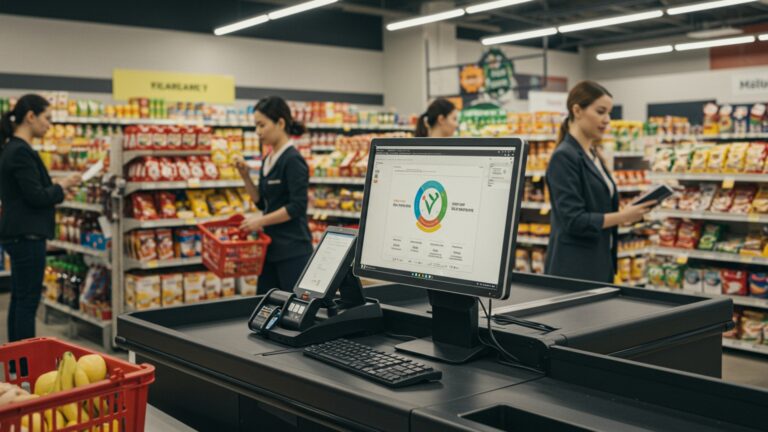A Comprehensive Guide to Mastering Essential POS Software Features
In today’s dynamic retail and hospitality sectors, the humble cash register has evolved into sophisticated POS software—a critical operational hub driving efficiency and growth. Modern systems transcend simple transaction processing, now seamlessly integrating capabilities like real-time inventory synchronization across multiple channels, robust customer relationship management for personalized loyalty programs. advanced analytics for predictive sales forecasting. Mastering these powerful features, from contactless payment processing to sophisticated stock management and employee performance tracking, transforms a business’s operational agility and customer engagement, enabling data-driven decisions that directly impact profitability and market competitiveness in an increasingly digital marketplace.

Understanding POS Software: The Core of Modern Retail Operations
In today’s fast-paced commercial landscape, the efficiency of your sales process directly impacts your business’s bottom line and customer satisfaction. At the heart of this efficiency lies Point of Sale (POS) software. A POS, traditionally, refers to the physical location where a transaction takes place – the checkout counter, the restaurant table, or the service desk. But, the term has evolved significantly. Modern pos software is a sophisticated digital system that manages not just sales transactions. a myriad of operational tasks critical to running a successful business.
- pos software
- pos software
The evolution of pos software has been remarkable. From simple electronic cash registers in the 1970s to complex, cloud-based. AI-powered systems today, the technology has continuously adapted to meet the demands of a dynamic market. Early systems were often bulky and expensive, requiring significant on-premise infrastructure. Today, many solutions are accessible via tablets and smartphones, offering unparalleled flexibility and affordability, making powerful tools available even to the smallest of startups.
Key Features Every Business Needs in POS Software
While the specific needs of a coffee shop might differ from those of a hardware store, several core features are universally essential for any robust pos software. Mastering these functionalities is the first step towards unlocking your system’s full potential.
Sales Processing & Transaction Management
This is the fundamental capability of any pos software. It enables fast, accurate. secure processing of customer transactions. Beyond simply ringing up sales, essential features include:
- Quick SKU Lookups
- Discounts & Promotions
- Refunds & Exchanges
- Gift Cards & Store Credit
- Split Payments
Rapidly find products by name, code, or barcode scan.
Apply percentage-based, fixed-amount, or BOGO (Buy One Get One) discounts effortlessly.
Streamline returns and exchanges, often linking back to original transactions.
Manage the issuance and redemption of digital or physical gift cards and store credits.
Allow customers to pay using multiple methods (e. g. , part cash, part card) or split the bill among several people.
For example, a busy restaurant using advanced pos software can easily split a table’s bill among multiple diners, each paying with their preferred method, significantly speeding up the checkout process during peak hours.
Inventory Management
Effective inventory management is crucial for preventing stockouts and overstocking, both of which can lead to significant financial losses. Top-tier pos software provides:
- Real-time Tracking
- Low Stock Alerts
- Vendor Management
- Barcode Generation & Scanning
- Multi-Location Inventory
Automatically updates stock levels with every sale, return, or new delivery.
Notifies you when items are running low, prompting reorders.
Organize supplier insights, purchase orders. receiving.
Create and scan barcodes for efficient inventory handling.
For businesses with multiple stores, track and transfer stock between locations seamlessly.
Consider a retail chain: their centralized pos software allows store managers to view inventory across all branches, enabling them to fulfill customer requests from another store if their own is out of stock, thus preventing lost sales.
Customer Relationship Management (CRM)
Building strong customer relationships is vital. Integrated CRM features within pos software help you grasp and engage with your clientele:
- Customer Profiles
- Loyalty Programs
- Targeted Marketing
- Feedback Collection
Store contact insights, purchase history. preferences.
Implement points-based, tier-based, or discount-based loyalty programs.
Use purchase data to segment customers and send personalized promotions.
Integrate tools for gathering customer feedback directly at the point of sale.
A cafe using its pos software to track customer loyalty can automatically offer a free coffee after every 10 purchases, fostering repeat business and making customers feel valued.
Employee Management
Your team is your greatest asset. POS software can help manage staff performance and access:
- Time Clock Integration
- Sales Performance Tracking
- User Permissions & Roles
Track employee work hours for accurate payroll processing.
Monitor individual employee sales, average transaction value. productivity.
Assign specific access levels to different staff members, ensuring data security and operational control.
Reporting & Analytics
Data is power. Comprehensive reporting tools within pos software provide actionable insights into your business performance:
- Sales Reports
- Inventory Reports
- Customer Reports
- Financial Summaries
- Trend Analysis
Daily, weekly, monthly. yearly sales breakdowns by product, category, or employee.
Identify best-selling products, slow-moving items. inventory turnover rates.
assess purchasing patterns, loyal customers. customer lifetime value.
Integrate with accounting software for a holistic view of your finances.
Spot seasonal trends, peak hours. opportunities for growth.
My own experience running a small electronics store highlighted the importance of these reports. By analyzing sales data from our pos software, we discovered that certain accessories sold significantly better on weekends. This insight allowed us to optimize staff scheduling and promotional displays, directly leading to increased sales for those items.
Payment Processing
Seamless and secure payment processing is non-negotiable. Modern pos software integrates with various payment gateways and methods:
- Credit/Debit Card Processing
- Mobile Payments
- Contactless Payments
- Gift Cards & Loyalty Points
EMV chip, magstripe. contactless (NFC) payments.
Apple Pay, Google Pay. other digital wallets.
Facilitate tap-to-pay options for speed and hygiene.
Integrated redemption processes.
Diving Deeper: Advanced POS Software Capabilities
Beyond the essentials, advanced pos software features can truly differentiate your business and prepare it for future growth.
Omnichannel Integration
In today’s retail environment, customers expect a consistent experience whether they shop online, in-store, or via mobile. Omnichannel pos software allows businesses to unify these touchpoints. This means a customer can buy online and return in-store, or check in-store availability from their phone, with all data seamlessly synchronized across platforms. This creates a cohesive brand experience that boosts customer loyalty.
E-commerce Integration
For businesses with an online presence, integrating your physical store’s pos software with your e-commerce platform (e. g. , Shopify, WooCommerce) is paramount. This ensures:
- Synchronized Inventory
- Unified Customer Data
- Centralized Sales Reporting
Prevents overselling online due to in-store purchases.
Maintain a single view of customer purchase history, regardless of the channel.
All sales data flows into one system for comprehensive analysis.
API Integrations
Application Programming Interface (API) integrations allow your pos software to communicate and share data with other critical business tools. Common integrations include:
- Accounting Software
- ERP Systems
- Marketing Automation Platforms
Automatically sync sales data, expenses. payroll with platforms like QuickBooks, Xero, or Sage.
For larger enterprises, integrate with Enterprise Resource Planning systems for a holistic view of operations.
Push customer data to email marketing tools (e. g. , Mailchimp) for automated campaigns.
A good example is a restaurant connecting its pos software to an online delivery platform via API. Orders placed online flow directly into the POS, appear on kitchen display systems. automatically deduct from inventory, streamlining the entire delivery process.
Hardware Compatibility
While software is key, it needs to work harmoniously with hardware. A comprehensive pos software solution typically supports a range of peripherals:
- Barcode Scanners
- Receipt Printers
- Cash Drawers
- Customer-Facing Displays
- Payment Terminals
For quick product identification.
Thermal or impact printers for customer receipts and kitchen tickets.
Secure storage for cash transactions, often triggered by the POS system.
Enhance transparency and customer engagement.
Integrated card readers for secure transactions.
Cloud-Based vs. On-Premise POS Software
Choosing between cloud-based and on-premise pos software is a significant decision. Each has distinct advantages and disadvantages:
| Feature | Cloud-Based POS Software | On-Premise POS Software |
|---|---|---|
| Data Storage | Data stored remotely on vendor’s servers, accessible via internet. | Data stored locally on your own servers or computers. |
| Accessibility | Accessible from any internet-connected device, anywhere. | Typically accessible only from devices within your local network. |
| Cost Structure | Subscription-based (SaaS), lower upfront cost, predictable monthly fees. | Higher upfront cost for software license and hardware, lower ongoing fees (after initial investment). |
| Maintenance & Updates | Managed by vendor, automatic updates, minimal IT involvement. | Requires in-house IT team or external support for maintenance and updates. |
| Scalability | Easily scalable up or down as business needs change. | More complex and costly to scale, often requires new hardware. |
| Security | Vendor responsible for security, often with robust measures (PCI compliance, encryption). | Your responsibility to manage and maintain security protocols. |
| Offline Capability | Some offer offline mode for limited functionality; requires internet for full sync. | Fully functional without internet. lacks remote access. |
Mastering Your POS Software: Actionable Strategies
Acquiring powerful pos software is only half the battle. Truly mastering its features requires a proactive approach.
Training Your Team Thoroughly
The best pos software is useless if your staff doesn’t know how to use it effectively. Invest in comprehensive training. This isn’t just about showing them which buttons to press; it’s about understanding the ‘why’ behind each feature. Provide hands-on practice, create cheat sheets for common tasks. offer ongoing refreshers. A well-trained team will process transactions faster, make fewer errors. provide superior customer service.
Customization for Your Business
Most modern pos software is highly customizable. Take the time to tailor it to your specific business needs. This might involve:
- Customizing Product Categories
- Setting Up Discount Rules
- Configuring User Roles
- Designing Receipt Templates
Organize your inventory logically for faster lookup.
Pre-configure promotions to reduce manual errors.
Assign appropriate permissions to staff members to maintain security.
Include your branding, return policies. loyalty program details.
My personal experience with a new restaurant POS rollout involved extensive customization of the menu interface, including modifiers for dishes and table layouts. This upfront effort, though time-consuming, drastically improved order accuracy and speed, reducing kitchen errors and improving guest satisfaction.
Regular Data Analysis
Your pos software is a goldmine of data. Don’t just generate reports; actively assess them. Look for patterns:
- Which products are your top sellers?
- Are there specific times of day or days of the week when sales peak?
- Which employees are consistently hitting sales targets?
- Are your marketing promotions actually driving sales?
Use these insights to make informed decisions about inventory ordering, staff scheduling, marketing campaigns. even menu or product development. Regular review sessions, perhaps weekly or monthly, can ensure you’re always acting on the latest insights.
Security Best Practices
Protecting sensitive customer and business data is paramount. Implement these security measures with your pos software:
- Strong Passwords
- Two-Factor Authentication (2FA)
- User Access Levels
- Regular Backups
- PCI Compliance
Enforce complex passwords for all users.
Where available, enable 2FA for administrative logins.
Strictly limit what each employee can access or modify based on their role.
Ensure your data is regularly backed up, especially if using an on-premise system. Cloud-based systems typically handle this automatically.
Ensure your payment processing adheres to Payment Card Industry Data Security Standard (PCI DSS) to protect cardholder data.
Leveraging Customer Data
The CRM features in your pos software are powerful tools for building loyalty. Use the collected customer data to:
- Personalize Offers
- Segment Customers
- Gather Feedback
Send birthday discounts or promotions based on past purchases.
Identify your most loyal customers and reward them appropriately.
Use purchase history to follow up with relevant surveys.
For example, a bookstore might use its pos software to identify customers who frequently buy science fiction. They can then send targeted emails about new sci-fi releases or author events, leading to higher engagement and sales.
Staying Updated
POS software is constantly evolving. Ensure you are taking advantage of new features and security patches by keeping your software updated. Cloud-based systems often update automatically. for on-premise solutions, schedule regular updates. These updates can introduce new functionalities that streamline operations, improve security, or enhance the customer experience.
Conclusion
Mastering your POS software’s essential features is not merely about processing transactions; it’s about empowering your business for growth and efficiency. My personal tip for true mastery is to go beyond the basics: actively explore every menu, practice with dummy orders. consistently assess the reports. For instance, understanding how to leverage integrated customer loyalty programs, a current trend, can transform a one-time buyer into a repeat customer, significantly boosting lifetime value. Consider how real-time inventory tracking, a recent development, prevents costly stockouts and overstock situations, directly impacting your bottom line. I’ve witnessed businesses dramatically improve their operational flow and billing accuracy just by diligently utilizing their POS’s reporting suite to identify sales patterns and peak hours. Your POS is a strategic command center, not just a cash register. Embrace its full potential, stay curious about new updates. continuously adapt its capabilities to your evolving business needs. This commitment will truly unlock unparalleled efficiency and a competitive edge.
More Articles
Simplify Your Transactions How to Master POS Billing Software for Accuracy
Future Proof Your Business How to Leverage Cloud Based POS Software Benefits
Unlock Flexibility How to Implement Android POS Software for Your Business
Elevate Your Restaurant How to Choose the Right POS Software for Success
Unleash Business Mobility How to Implement Mobile POS Software Solutions Seamlessly
FAQs
What’s this guide all about?
This guide is your ultimate resource for truly understanding and making the most of the essential features in Point-of-Sale (POS) software. It’s designed to help you streamline your business operations and boost efficiency.
Who is this guide for?
It’s perfect for anyone who uses or plans to use POS software – whether you’re a small business owner, a retail associate, a manager looking to optimize processes, or just someone wanting to get more out of their current system.
What specific POS features will I learn to master?
You’ll dive deep into critical areas like efficient inventory management, fast and accurate sales processing (including returns and exchanges), robust customer relationship management (CRM), detailed reporting and analytics. easy employee management tools.
Is it hard to learn all these POS features?
Not at all! The guide breaks down complex topics into simple, actionable steps. We use practical examples and clear explanations to make learning straightforward and easy to apply to your day-to-day operations.
How will mastering POS software actually help my business?
By mastering these features, you can significantly speed up transactions, minimize errors, keep precise track of your stock, grasp your customers better. make smarter, data-driven business decisions. This all leads to increased efficiency, happier customers. better profitability.
Does this guide focus on a particular POS brand?
No, the guide focuses on universal features and best practices found across most modern POS systems. The principles and techniques you learn will be highly transferable, regardless of the specific software platform your business uses.
Can I really improve my sales performance with this guide?
Absolutely! By understanding and utilizing your sales data through powerful reporting, optimizing inventory to prevent stockouts. leveraging CRM features to build customer loyalty, you’ll be well-equipped to identify opportunities and significantly boost your sales performance.




